Autos
BMW speed demons
Two fun, flashy high-performance rides
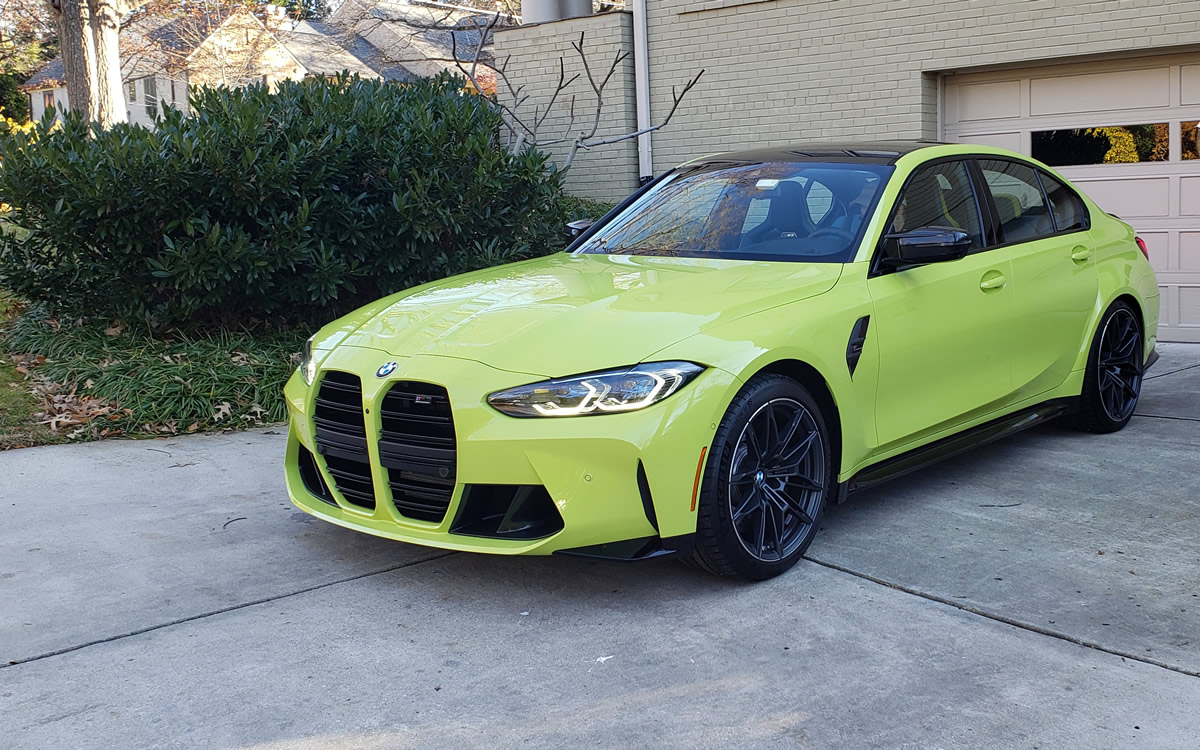
Just in time for Pride month, two BMW sport sedans celebrate just how fun, fast and flashy a true high-performance ride can be.
BMW M3 COMPETITION xDRIVE
$78,000
Mpg: 16 city/22 highway
0 to 60 mph: 3.2 seconds
Talk about a pocket rocket, it’s hard to beat the thrill of the BMW M3 Competition xDrive sport sedan. This 503-horsepower speed demon streaks from 0 to 60 mph as fast as many premium sportsters, including the glitzy new 621-horsepower Maserati MC20 super coupe — which costs a whopping $215,000. Along with the lower price tag, the M3 has room for twice as many passengers and boasts three times as much rear cargo space as that two-person Maserati.
While this high-test BMW may be classified as a compact car, there’s ample legroom, decent headroom and a sharply angled dashboard for improved driver visibility. My test car had optional carbon-fiber racing bucket seats, trimmed in snazzy aqua blue and lemon yellow and backlit with illuminated M logos. While the futuristic design is truly a piece of art, scooching in and out of those sci-fi seats — which sit lower than standard seats and have sharply angled side bolsters—was quite a challenge. And, hello, it didn’t help that a “thigh separator” (a raised, hard-padded object stuck in the middle of the bottom cushion) protruded oh-so-close to my scrotum. Let’s just say I got more than my fill of butt-clenching exercises during the week-long test drive.
But once situated comfortably behind the sculpted steering wheel, all was forgiven. The M3 cabin is superbly sleek, with modish armrests and a duo of sweeping digital display screens. The eight-speed automatic transmission is wicked smooth, making it practically unnoticeable as the car shifts through gears. And the overall handling is rousing yet controlled, especially with the all-wheel drive. When not grooving to the guttural exhaust growl, I enjoyed jamming to a sparkling 16-speaker Harman Kardon stereo. There are plenty of other creature comforts, such as smartphone integration, wireless charging pad and Wi-Fi hotspot. Driving aids include blind-spot monitor, head-up display, collision alert and pedestrian detection. There’s even a system to automatically pull the car over if the driver falls asleep at the wheel. As you could tell, I didn’t have to worry about that happening.
BMW M440i GRAN COUPE xDRIVE
$60,000
Mpg: 22 city/29 highway
0 to 60 mph: 4.5 seconds
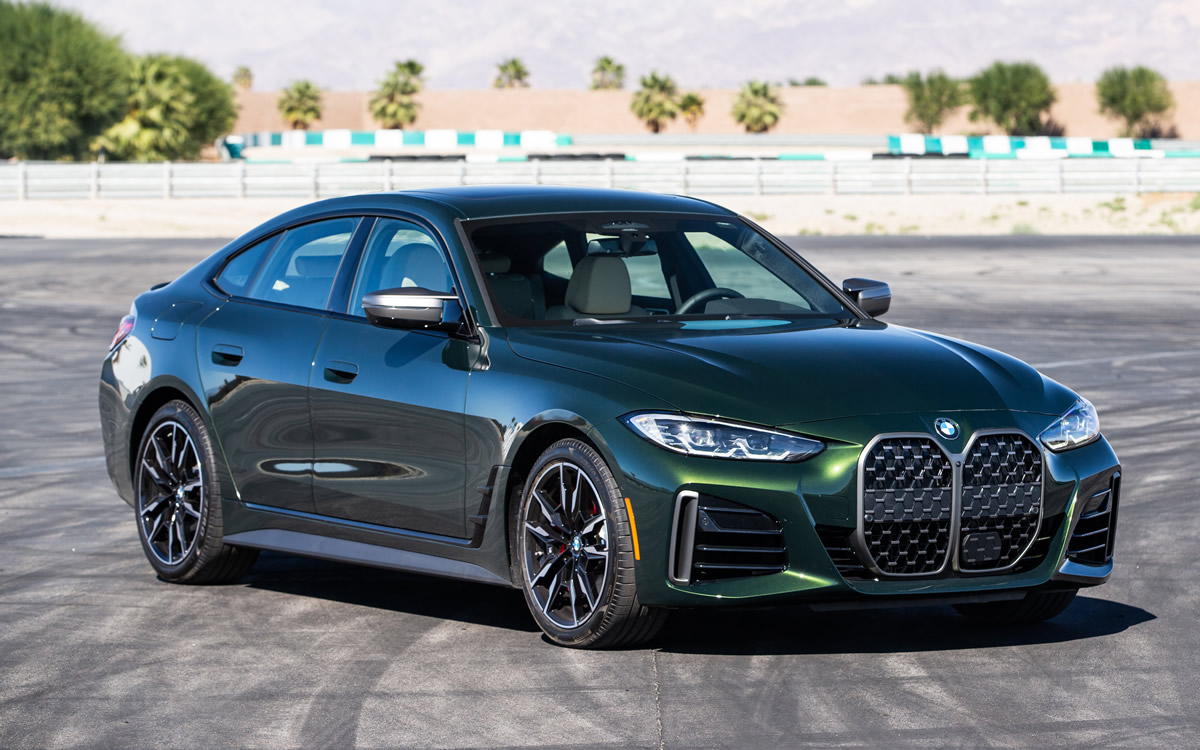
If the BMW M3 Competition xDrive is a badass sport sedan, then the M440i Gran Coupe xDrive is more buttoned-down — but only to a point. The M Sport trim level on both vehicles includes sturdier brakes, suspension, and stability control. And each car can be ordered with all-wheel drive, a big plus considering the number of downpours and icy road conditions in this part of the country.
But the M3 is extra taut, tight and tuned — a race car enthusiast’s dream — whereas the M440i feels as suave as an Aston Martin. Think of it as trading flash for finesse. Styling is just as sharp, though the body cladding, side air vents and rear spoiler are all less pronounced on the 4 Series. It’s also wider and sits higher off the ground. And instead of having a trunk lid, the M440i is a hatchback with a more swoopy profile and easier access to the cargo area. Despite smaller wheels and about two-thirds the horsepower of an M3, the M440i is still plucky and a delight to drive.
And safety features and optional amenities are comparable. Inside, the cabin exudes refined BMW luxury but loses the Jedi spaceship vibe so noticeable on the M3. Gauges and the infotainment layout are the same, with similar but fewer performance-oriented readouts on the digital screens. I still found the M440i cabin to be plenty sporty, with premium fit and finish. And there’s beaucoup insulation to block annoying road noise. Perhaps most important, my tush welcomed the return to more traditional seats.
Autos
Sporty sedans: BMW 530i xDrive, Mercedes AMG CLA 3
Tariffs are here and the result is financial chaos
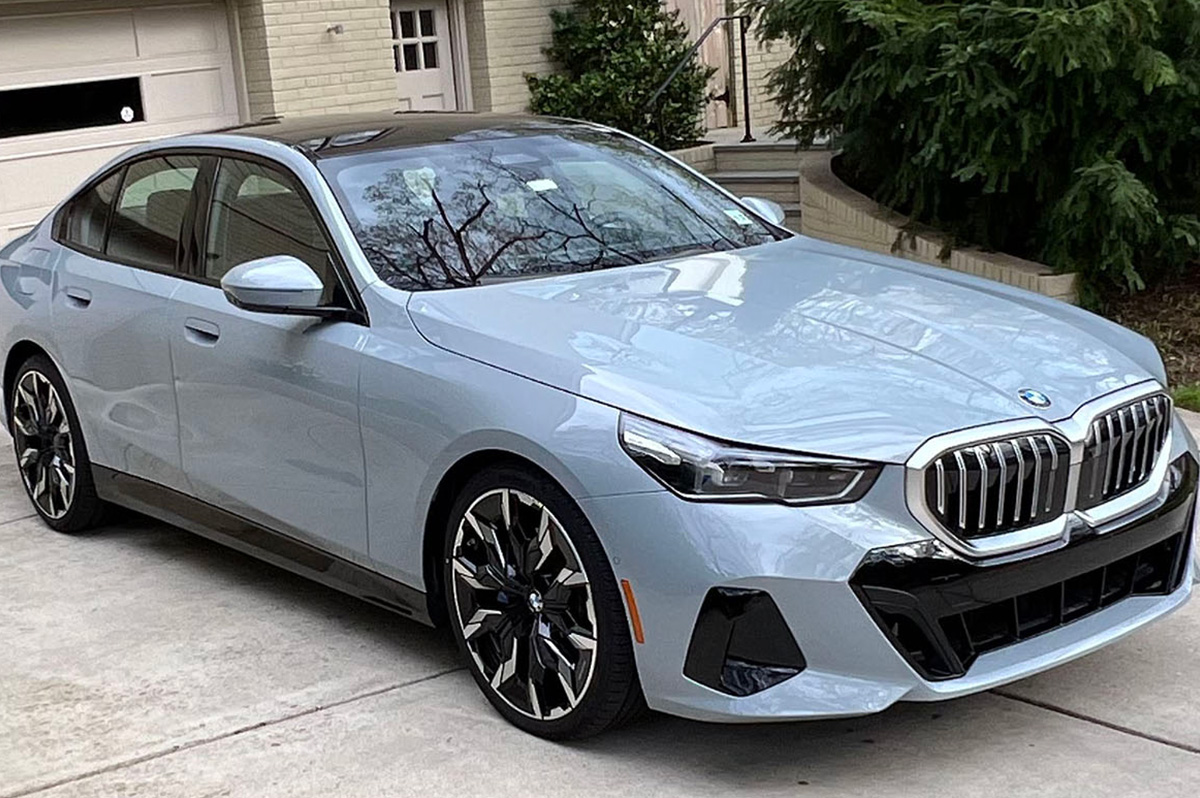
It’s official: Tariffs are here, and the result is financial chaos.
So, what to do when purchasing a new vehicle? If you need one in the not-so-distant future, buy sooner (like yesterday) rather than later. Expect prices to rise quickly, as inventory dwindles, demand soars, and automaker incentives evaporate. Of course, if a new ride isn’t a priority for at least a year or three, then hold off until the dust settles.
But for those of you looking for new wheels now, I recently drove two sport sedans that were a pleasant reprieve from the usual plethora of pickups, minivans, and SUVs.
BMW 530i xDRIVE
$63,000
MPG: 28 city/35 highway
0 to 60 mph: 5.5 seconds
Cargo space: 18.4 cu. ft.
PROS: Rakish looks. Race-car vibe. Rock-star amenities.
CONS: Rad-but-quirky infotainment system. Rich price.
IN A NUTSHELL: Classic good looks, from the iconic grille and swept-back headlights to chiseled side panels and a tasteful tush. For a gearhead like me, the BMW 530i xDrive — completely redesigned last year — is as rapturous as Michelangelo’s David. Everything here is in proportion, from the design to the drivetrain, which — along with a gutsy 255-hp turbo and all-wheel drive — helps deliver a divine experience behind the wheel. Even better, my test car came equipped with the heavenly M-Sport Package: 21-inch wheels, athletic suspension, and assorted styling upgrades.
A tech-laden cabin is outfitted with a sparkly 12.3-inch digital instrument cluster and 14.9-inch touchscreen infotainment system. With the windshield head-up display and a slew of knobs and toggle switches in the center console and on the steering wheel, I wondered if this is how it feels to pilot the Space Shuttle. There is even a back-lit interaction bar with touch-sensitive controls to adjust vent direction and other climate control settings.
All this gadgetry takes some getting used to, but the overall effect is dazzling. While a 12-speaker Harman Kardon stereo comes standard, I was jammin’ to the 16-speaker Bowers & Wilkins premium audio. Of course, such options add up quickly (on my test car, the extras totaled $13,000).
Just how fun is this car? In my favorite episode of “Hacks,” sassy Jean Smart drives a rockin’ Rolls Royce Wraith. Trust me, this four-door BMW is every bit the badass as that $300,000 super coupe.
MERCEDES AMG CLA 35
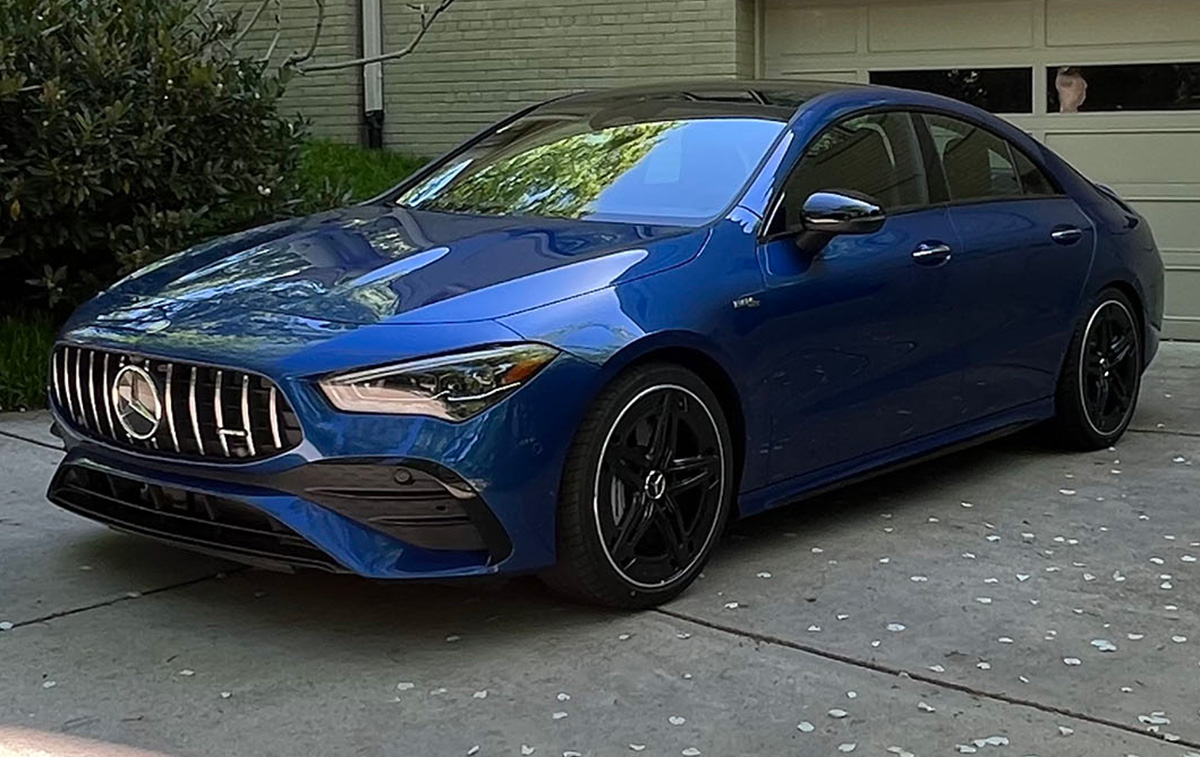
$58,000
MPG: 22 city/29 highway
0 to 60 mph: 4.8 seconds
Cargo space: 11.6 cu. ft.
PROS: Slick styling. Spiffy cabin. Sublime seats.
CONS: Smallish trunk. So-so rear headroom and legroom.
IN A NUTSHELL: Need a smaller sedan that’s just as marvy as the midsize BMW i530? Look no further than the compact Mercedes CLA-Class, which is 14 inches shorter. That’s a benefit when jockeying for parking or navigating rush hour.
Another plus: This is Mercedes’s least expensive sedan, available in three trim levels. All come with the same potent turbo but in varying power levels. The base model starts at $46,000, but I tested the first of two high-performance versions: the AMG CLA 35, which costs $12,000 more. You can open your wallet even further to snag the $67,000 AMG CLA 45.
But why bother? The AMG CLA 35 is plenty quick — faster than the BMW i530 — and boasts sport-tuned brakes, deft handling and a gritty-sounding exhaust system. The laundry list of standard features includes all-wheel drive, automated parking, gobs of the latest safety gizmos and even something called “safe-exit assist,” which prevents passengers from opening a door into traffic or speeding cyclists.
The interior is pure Mercedes, with top-notch materials, customizable ambient lighting and Burmester surround-sound audio. The overall layout—sleek and modern, but with elegant stitching in the seats and on the door panels and dashboard—is comfortable and user-friendly. Digital displays and touchscreens are similar to what’s in the BMW i530, just smaller.
Size matters, of course, which is why this vehicle’s shorter length can be a blessing but also a curse, especially when trying to squeeze passengers with longer legs into the backseats. And the dramatically sloped roofline, attractive from the outside, limits the amount of rear headroom and cargo space. Thank the automotive gods for panoramic sunroofs, which—at least for anyone in the front seats—makes this cabin feel surprisingly spacious.
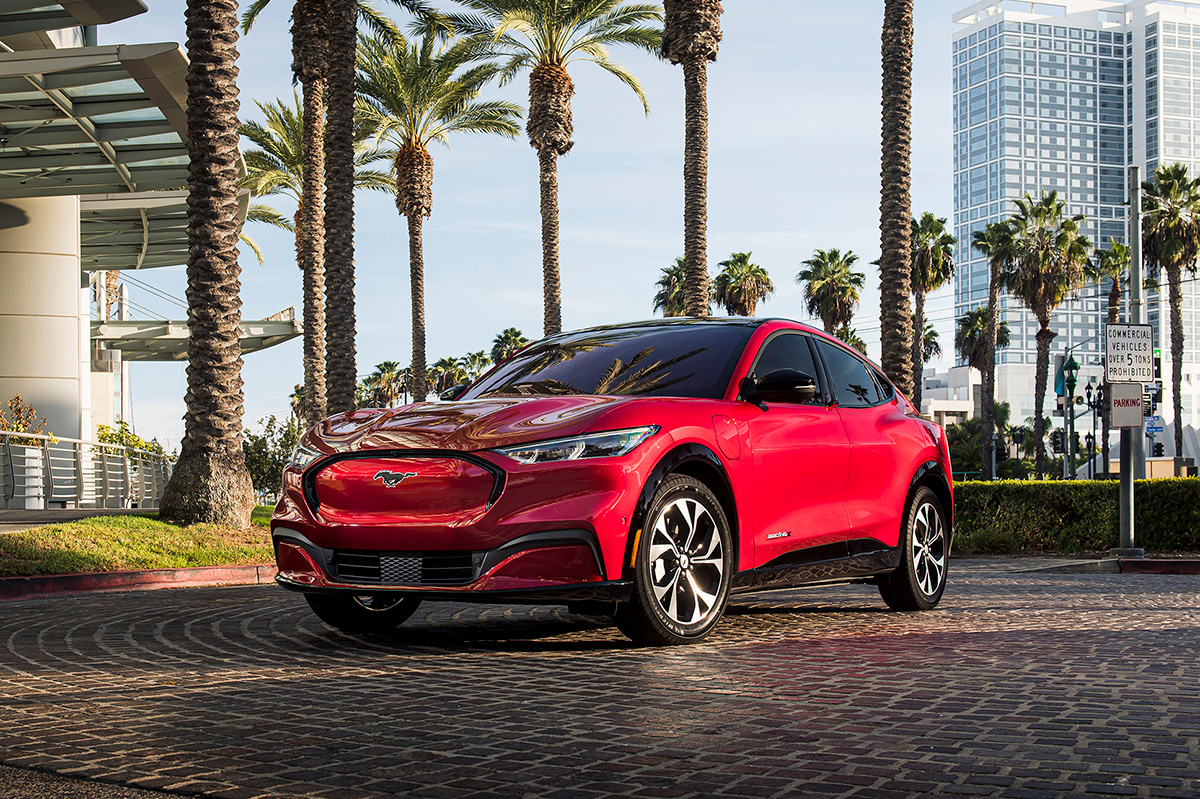
Looking to roll into something new? With all the buzz about 25% tariffs, it’s the perfect time to grab a new ride before prices soar—especially for electric vehicles, which may soon wave goodbye to those oh-so-attractive federal tax credits. Whether you are an eco-conscious commuter or just need a chariot for weekend getaways, these three green machines offer some serious swagger.
FORD MUSTANG MACH-E PREMIUM
$42,000
Range: 250-300 miles (depending on battery pack)
0 to 60 mph: 5.2 seconds
Cargo space: 29.7 cu. ft.
PROS: Zippy. Sporty feel. Ample battery range.
CONS: Bit bumpy over potholes. Limited seat adjustments.
IN A NUTSHELL: With sleek curves and a design that’s hotter than a drag queen’s heels on the runway, the Ford Mustang Mach-E blends both power and flair. The exterior colors are vibrant and unapologetically bold, just like the rainbow after a storm. Three trim levels, but opt for the spiffy Premium version—which was what I drove and is a nice step up from the $37,000 base model. It also costs a lot less than the gutsy GT, which tops $55,000.
Inside, the Mach-E is like driving a chic lounge on wheels. Toggling through the 15.5-inch touchscreen feels like navigating through the latest TikTok trends. A panoramic glass roof and faux-leather upholstery come standard, but assorted add-ons—standard features with the Premium trim—include hands-free power liftgate, multicolor ambient lighting and 10-speaker Bang & Olufsen stereo. There’s also plenty of space for all the essentials: totes, coats and besties.
And let’s not forget about battery range—there’s enough juice here to take you through a whole day of driving without needing a recharge. With Ford’s fast-charging network, it’s easy to be powered up quicker than you can say, “Ride ‘em, cowboy!” Well, almost.
How popular is this EV, which looks more like a hot hatchback than an SUV? Last year, sales spiked 27% and outsold the iconic gas-powered Mustang. So yes, the Mach-E Premium isn’t just any vehicle—it’s an experience that’s, well, electric.
KIA SPORTAGE PHEV X-LINE PRESTIGE
$44,000
MPGe: 84 city/highway combined
0 to 60 mph: 7.1 seconds
Cargo space: 39.6 cu. ft.
PROS: Comfy. Comely cabin. Oodles of passenger room.
CONS: Clunky dual-use dashboard controls. Bit noisy interior.
IN A NUTSHELL: Next up: the 2025 Kia Sportage PHEV X-Line Prestige, a compact plug-in hybrid that combines style, strength and versatility into one dazzling package. If the Mach-E Premium is a glam EV star, I found the Sportage PHEV to be an SUV showstopper.
Under the hood, power comes from an electric motor and gas-powered backup, so you get the best of both worlds—whether cruising on green energy or unleashing your inner diva. The all-electric range is almost 35 miles, and all-wheel drive is standard—which helps keep things steady, no matter the weather.
Inside, it’s pure comfort. While there are two hybrid trim levels, even the base-model—the X-Line—is fairly loaded: LED headlights/taillights, dual-zone automatic climate control, remote start, power liftgate, nav system, wireless charging pad, smartphone integration and more.
For my weeklong test vehicle, I was spoiled with the X-Line Prestige, which is full of a ridiculous number of amenities and safety gear. Let’s just say the clever cabin design would make the folks at Ferrari blush. Oh, and thanks to the pristine acoustics from the Harmon Kardon audio, I could have sworn the cast of “Hamilton” was right there with me belting out each tune. “Blow Us All Away,” indeed.
MERCEDES AMG C 63 S E
$87,000
MPGe: 40 city/highway combined
0 to 60 mph: 3.3 seconds
Cargo space: 11.6 cu. ft.
PROS: Snazzy. Lightning fast. Haute handling.
CONS: Pricey. Quirky steering-wheel controls.
IN A NUTSHELL: Jonesing for an exciting, eco-friendly sedan? Then look no further than the Mercedes AMG C 63 S E plug-in hybrid, which gets the adrenaline pumping each time you slip behind the wheel.
Under the hood, there’s a staggering 671 horsepower—enough to leave competitors in the dust and make them more than a little jealous. This AMG-tuned Mercedes—the quickest C-Class ever—blasts from 0 to 60 mph in just 3.3 seconds, faster than your heart rate when seeing your next crush at a circuit party. And that’s not even the best part—the shapely contours of this sportster are as chiseled as Luke Evans’ check bones.
Inside, the cockpit is like a designer outfit made for a fab night out—high-quality material everywhere, as well as branded sport seats with top-tier upholstery and stitching. One downside: the steering-wheel controls, which look tasteful but can be a tad too touch-sensitive at times.
Still, this elegant ride exudes more than enough bells and whistles to maintain a constant state of euphoria.
Autos
Mad about Mercedes — and a Mini Countryman, too
These three spiffy SUVs not too basic, not too complicated
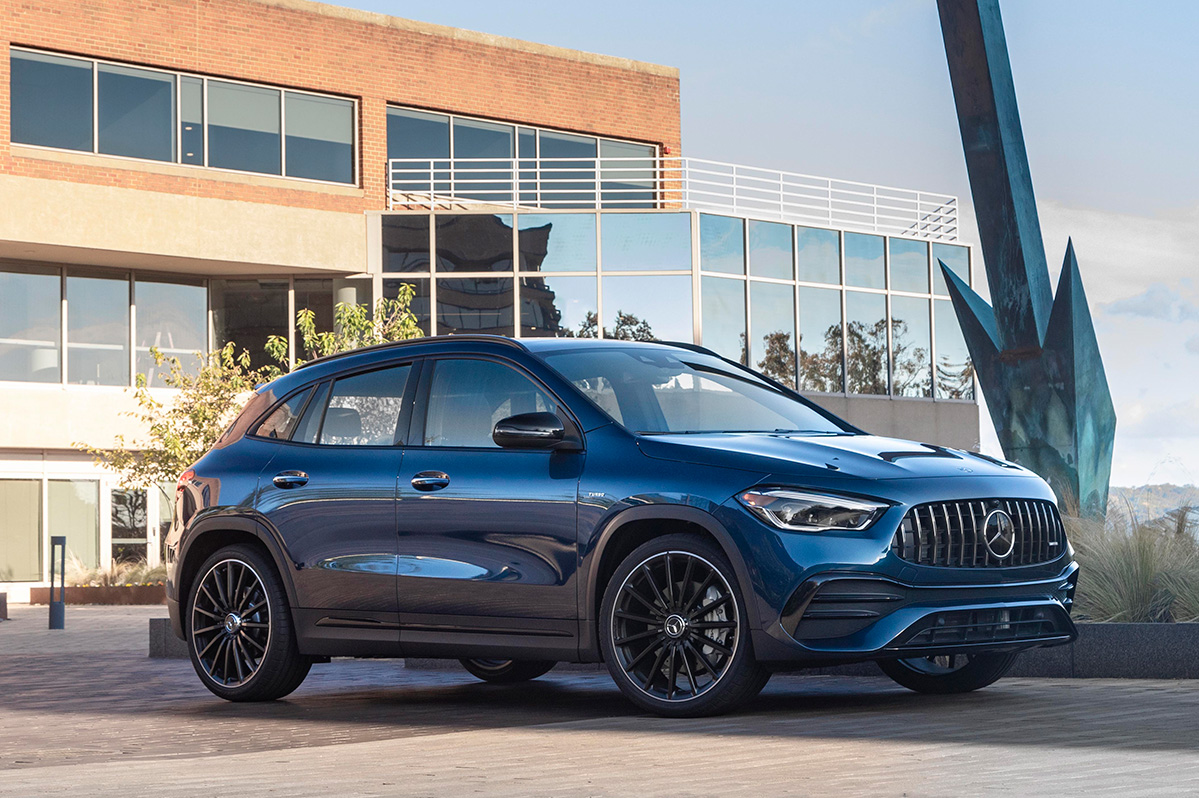
Not too basic, not too complicated. That’s what I enjoyed most about three spiffy SUVs recently. Call it the Goldilocks effect, but each ride—two Mercedes and a Mini Countryman—seemed just right. That’s a big plus in today’s world of extremes.
MERCEDES AMG GLA 35
$59,000
MPG: 22 city/28 highway
0 to 60 mph: 4.7 seconds
Cargo space: 15.4 cu. ft.
PROS: Affordable luxury, smooth suspension, zippy.
CONS: Bit noisy inside, so-so storage, costly options.
IN A NUTSHELL: The subcompact GLA—the most affordable Mercedes sold in the U.S.—comes in two trim levels. With the average price of a vehicle topping $48,000, the base-model GLA 250 is a bargain at $43,000. On paper, the stats for acceleration, handling and braking look spot on. Ditto the fine amenities, including faux-leather seats, ambient lighting, wireless charging pad and power liftgate. Toss in numerous safety features—including forward-collision warning, blind-spot alert, an automated parking system—and what could be better? The answer is the sport-tuned AMG GLA 35, which is the vehicle I tested. Zippier, grippier and ritzier than its entry-level sibling, this saucy SUV is also pricier. And beware: The long list of options—such as head-up display, surround-view camera, illuminated door sills—can add up quickly. But oh, what a thrill. Stomp on the accelerator, and the GLA 35 scoots from 0 to 60 mph in just 4.7 seconds—a full two seconds quicker than the GLA 250. Along with a more powerful engine and all-wheel drive, there’s now a 48-volt hybrid-assist system. The GLC 35 also flaunts aggressive styling, including a sexy rear spoiler, large dual exhaust tips and bigger wheels. Fave feature: the flat-bottom, performance-oriented steering wheel with spiffy paddle shifters and a panoply of user-friendly buttons and dials.
MERCEDES AMG GLC 43 COUPE
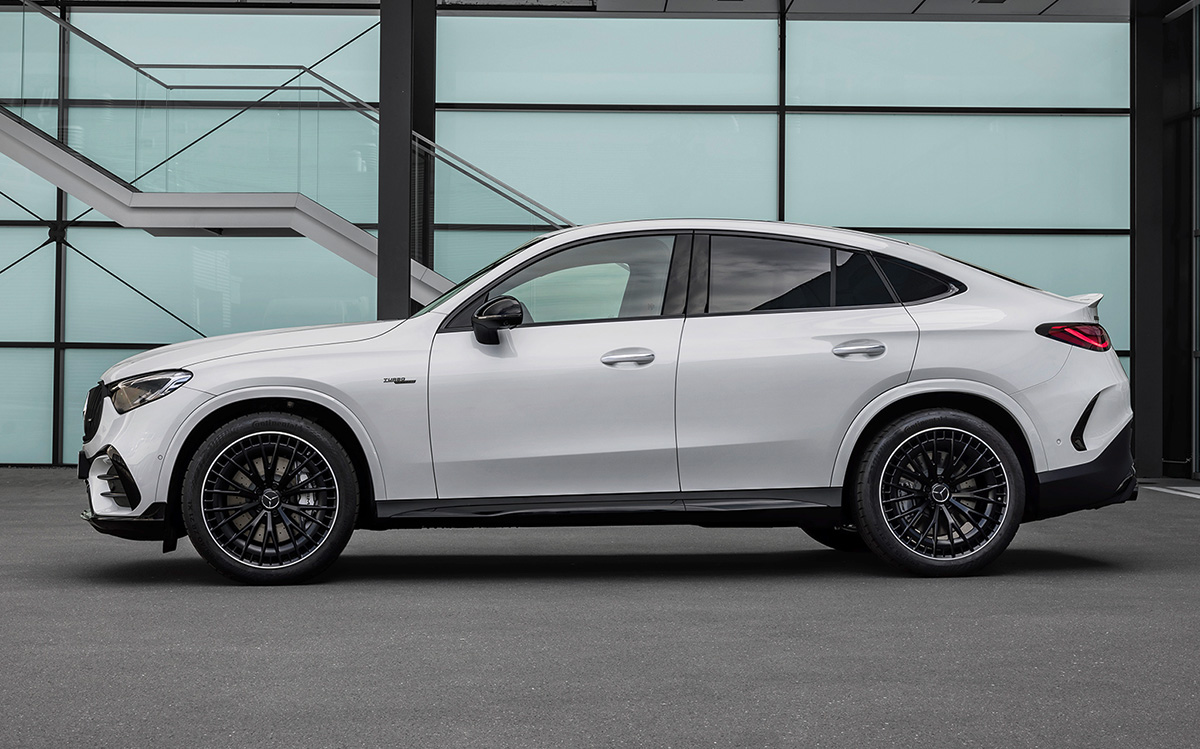
$70,000
MPG: 18 city/24 highway
0 to 60 mph: 4.7 seconds
Cargo space: 19.2 cu. ft.
PROS: Posh styling, potent power, quiet cabin.
CONS: Pricey, limited rear visibility, reduced cargo room.
IN A NUTSHELL: Stepping up from the baby Mercedes GLA, the larger GLC—though technically a compact—is 12 inches longer. What’s more, this hauler comes with choice of five trim levels. And you can choose from either a traditional square-back design or sloped coupe-like styling. Confused? Don’t be. Just trust that the AMG GLC 43 Coupe, which is really an SUV, checks all the boxes. There’s plenty of drama here, with a bulging snout and sinuous shape that any diva would love. There’s also plenty of power, with a gritty turbo that allows the GLC to accelerate just as fast as the much lighter GLA. And the interior is stunning: NASCAR-like bucket seats, gigantic infotainment touchscreen and reinforced window glass to better insulate the cabin. A clever nav system can project traffic and other info onto the head-up display on the windshield, and rear automatic braking helps anticipate and prevent a back-end collision. Sure, the low-slung roofline cuts into rear-seat headroom and cargo space. But for me, the sacrifice was worth it. After all, it’s hard to imagine any other glam-but-gutsy ride equally at home on a fashion runway or at the racetrack.
MINI COUNTRYMAN ALL4
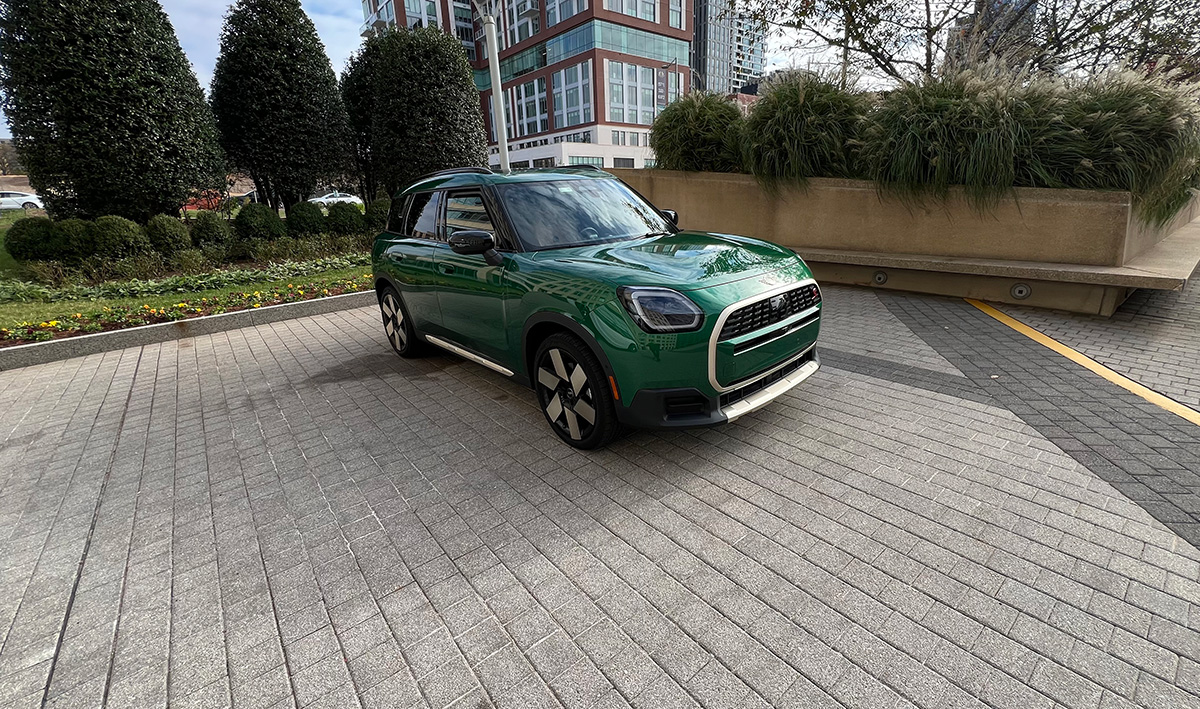
$40,000
MPG: 24 city/32 highway
0 to 60 mph: 5.9 seconds
Cargo space: 24.9 cu. ft.
PROS: Bigger, faster, better.
CONS: Almost too big, bit less playful, higher MSRP.
IN A NUTSHELL: Fully redesigned for 2025, the Mini Countryman enjoys a slew of up-market changes but retains some of its retro quirks. Larger than before, this latest model—with so much extra room for passengers and cargo—feels comfy and spacious. Almost too much so. At first blush, I was reminded of a Subaru Forester or Outback. Both fine vehicles, but without that familiar Mini vibe. Luckily, the steering wheel, head-up display and large Frisbee-shaped infotainment display all channel the previous Countryman. Ditto the overall exterior, which now boasts a redesigned grille, sleeker headlights and refined rear treatment. Yet I missed seeing all the toggle switches and some other playful touches. In their place, though, is a groovy dashboard with nifty LED lighting that changes colors based on the driving mode. While some digital readouts initially seemed too techy, they ended up being very user friendly. And there are two standout features: a huge panoramic moonroof and the use of sustainable materials for the carpeting, seats and such.
-

 The Vatican19 hours ago
The Vatican19 hours agoAmerican cardinal chosen as next pope
-

 a&e features1 day ago
a&e features1 day agoYour guide to the many Pride celebrations in D.C. region
-

 U.S. Supreme Court3 days ago
U.S. Supreme Court3 days agoSupreme Court allows Trump admin to enforce trans military ban
-

 District of Columbia2 days ago
District of Columbia2 days agoWorldPride permits for National Mall have yet to be approved






